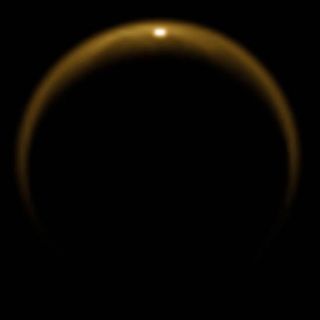
SAN FRANCISCO ? A giant hydrocarbonlake on Saturn's moonTitan is mirror-flat and surprisingly shallow, with average depthscomparableto that of a backyard swimming pool, according to a new study.
Ontario Lacus,the largest lake in Titan'ssouthern hemisphere, covers about 6,000 square miles (15,000 squarekilometers). While big, it's not exactly fierce; Ontario's waves areless thana dime's-width high, and the lake can't be any deeper than 24 feet (7.4meters)in any one spot, researchers found.
"The volume of hydrocarbons is actuallyquitesmall," said lead author Lauren Wye of Stanford University, whopresentedher team's results here Wednesday (Dec. 15) at the fall meeting of theAmericanGeophysical Union. "The shallowness was a surprise."
The lakes ofTitan
Titan, Saturn's largest moon,is a frigid place,with average surface temperatures aroundminus 290 degrees Fahrenheit (minus 179 degrees Celsius).It has athick, nitrogen-rich atmosphere and a weather cycle based on methane.Scientists recently discoveredthat lakes filled with liquid hydrocarbons ? stuff like methane, ethaneandpropane ? dot its surface.
Ontario Lacus is the biggest of theselakes south of Titan'sequator. It spans a huge area ? nearly as much as its Earth namesake,NorthAmerica's Lake Ontario.
Wye and her team used radarmeasurements made by NASA's Cassini spacecraftduring two Titan flybys? one in July 2009 and the other in January 2010 ? to figure out howhighOntario's waves get, and how deep the lake goes.
Get the Space.com Newsletter
Breaking space news, the latest updates on rocket launches, skywatching events and more!
Researchers had previously mapped someof Ontario's depthsclose to its shoreline. But the new results represent some of the firstsoliddepth measurements of a Titan lake across its entire length andbreadth, Wyesaid.
In a confirmation of previous findings,the researchersdetermined that Ontario's surface is flat as flat can be, with maximumwaveheights of less than 1 millimeter (0.04 inches). No liquid body onEarth'ssurface can come close to matching this degree of smoothness,researchers havesaid.
These measurements suggest that Titan'swinds may have beenvirtually nonexistent at the time measurements were made, Wye said.It's alsopossible that the hydrocarbons filling Ontario Lacus areextraordinarilyviscous.
"We have no idea what these materialpropertiesare," she told SPACE.com.
The researchers also found that Ontariois surprisinglyshallow for such an enormous body. Its average depth is somewherebetween 1.3and 10.5 feet (0.4 ? 3.2 meters), and the maximum depth is in theneighborhoodof 9.6 to 24.4 feet (2.9 ? 7.4 meters). (The team derived lower andupperbounds for these values from Cassini's measurements.)
These numbers put Ontario Lacus' volumesomewhere between 1.7and 12 cubic miles (7 to 50 cubic km), researchers said. Earth's LakeOntario,by contrast, holds about 393 cubic miles (1,640 cubic km) of water.
Northern lakesdifferent
The team also looked at a few lakes inTitan's northernhemisphere, which has considerably more lakes than the south. One ofthem, thehuge Ligeia Mare, was deeper ? though the researchers couldn't put ahardnumber on how deep it goes, since Cassini's radar signal lessens instrength beyonddepths of 26 feet (8 meters) or so.
"All we can say is it's likely deeperthan eight metersin much of the center of the lake," Wye said.
The depth differences likely reflect adifference in formationmechanisms. Ontario Lacus appears to be a sedimentary basin, accordingto Wye.
"It may be a relatively flat basin,like Racetrack Playain Death Valley," California,she said.
Ligeia Mare, on the other hand,probably arose from somedifferent process. The new study, and others like it, could helpresearcherstease out just what these various formation mechanisms are, accordingto Wye.
"Depth maps like these can be used forthatpurpose," she said.
- Image Gallery: Cassini's LatestDiscoveries
- Video: Parachuting onto Titan
- Giant Lake Confirmed on Saturn's MoonTitan
Join our Space Forums to keep talking space on the latest missions, night sky and more! And if you have a news tip, correction or comment, let us know at: community@space.com.

Michael Wall is a Senior Space Writer with Space.com and joined the team in 2010. He primarily covers exoplanets, spaceflight and military space, but has been known to dabble in the space art beat. His book about the search for alien life, "Out There," was published on Nov. 13, 2018. Before becoming a science writer, Michael worked as a herpetologist and wildlife biologist. He has a Ph.D. in evolutionary biology from the University of Sydney, Australia, a bachelor's degree from the University of Arizona, and a graduate certificate in science writing from the University of California, Santa Cruz. To find out what his latest project is, you can follow Michael on Twitter.
